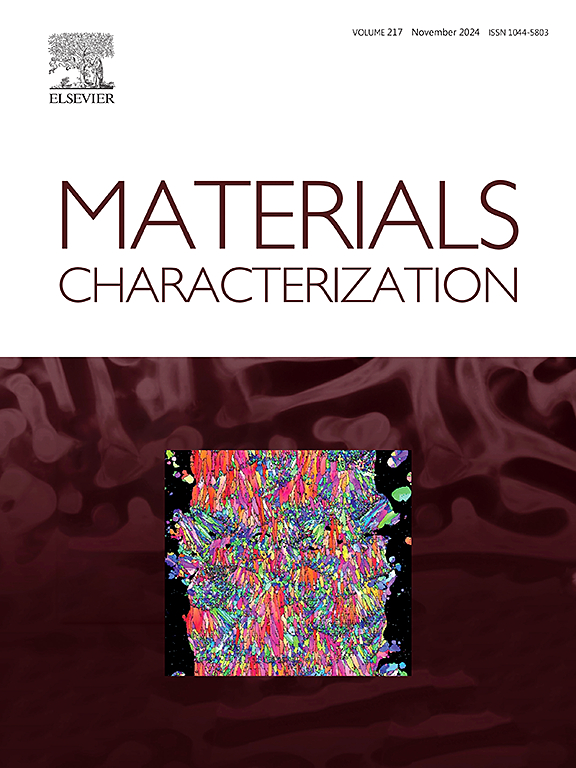900℃时合成孪晶TiAl双晶各向异性诱导的非均匀变形行为
IF 4.8
2区 材料科学
Q1 MATERIALS SCIENCE, CHARACTERIZATION & TESTING
引用次数: 0
摘要
多合成孪晶(PST) TiAl晶体表现出卓越的高温力学性能,通过定向技术使其排列良好的片层取向能够将使用温度提高到900°C。为了解决PST单晶的强变形各向异性,本研究探索了两个PST晶体之间的变形协调,通过定制取向组成来实现强度和延性的权衡。以两个取向组成不同的双晶B1(65°,8°)和B2(20°,15°)为研究对象,EBSD检测了它们的取向,确定了取向偏差Δθ12相似,分别为61°和66°,同时引入了S1单晶(23°)作为参考。SEM和EBSD分析阐明了变形行为,包括裂纹扩展、位错滑移和潜在的孪生,并通过TEM观察讨论了进一步的界面破坏机制和位错机制。结果表明,双晶的变形总是从较软的晶粒开始,然后扩展到较硬的晶粒。双晶的变形相容性决定了是否发生非均匀变形,以加工硬化效应还是应变配位效应为主要强化方式。高温有利于γ相孪晶(γ变量依赖)和α2相位错滑移(与α2圆柱滑移倾向有关)。对位错行为的进一步讨论表明,普通位错对初始变形能力有显著影响,而激活新生孪晶和超晶格位错的能力影响界面破坏容限能力和随后的变形协调。进一步了解双晶的变形各向异性有助于通过设计适当的片层成分来实现强度与延性的权衡。本文章由计算机程序翻译,如有差异,请以英文原文为准。

Anisotropy-induced nonuniform deformation behavior in polysynthetically twinned TiAl bicrystals at 900 °C
Polysynthetically twinned (PST) TiAl crystals exhibit remarkable high-temperature mechanical properties, and their well-aligned lamellar orientations via directional technology enable a potential increase in service temperature to 900 °C. To address the strong deformation anisotropy of PST single crystals, this study explores deformation coordination between two PST crystals to achieve the strength-ductility trade-off via tailored orientation composition. Focusing on two bicrystals B1 (65°, 8°) and B2 (20°, 15°) with distinct orientation compositions, EBSD examined their orientations, and the misorientation Δθ12 is confirmed to be similar, as 61° and 66° respectively, while introducing a single crystal of S1 (23°) as a reference. SEM and EBSD analyses elucidate deformation behaviors, including crack propagation, dislocation slip, and potential twinning, and the further interfacial failure mechanism and dislocation mechanism were discussed via TEM observation. Results demonstrate that the deformation of bicrystals always initiates at the relatively softer grain and propagates to harder counterparts. Bicrystals' deformation compatibility determines whether the nonuniform deformation occurs and whether the work hardening effect or the strain coordination effect is the dominant strengthening mode. Elevated temperatures facilitate γ-phase twinning (γ variant-dependent) and α2-phase dislocation slip (related to α2 cylindrical slip tendency). Further discussion on the dislocation bahaviors indicates that ordinary dislocations significantly affect the initial deformation capacity, while the ability to activate newborn twins and superlattice dislocations affects the interfacial failure tolerance capacity and subsequent deformation coordination. A further understanding of bicrystals' deformation anisotropy facilitates achieving the strength-ductility trade-off by designing appropriate lamellae composition.
求助全文
通过发布文献求助,成功后即可免费获取论文全文。
去求助
来源期刊

Materials Characterization
工程技术-材料科学:表征与测试
CiteScore
7.60
自引率
8.50%
发文量
746
审稿时长
36 days
期刊介绍:
Materials Characterization features original articles and state-of-the-art reviews on theoretical and practical aspects of the structure and behaviour of materials.
The Journal focuses on all characterization techniques, including all forms of microscopy (light, electron, acoustic, etc.,) and analysis (especially microanalysis and surface analytical techniques). Developments in both this wide range of techniques and their application to the quantification of the microstructure of materials are essential facets of the Journal.
The Journal provides the Materials Scientist/Engineer with up-to-date information on many types of materials with an underlying theme of explaining the behavior of materials using novel approaches. Materials covered by the journal include:
Metals & Alloys
Ceramics
Nanomaterials
Biomedical materials
Optical materials
Composites
Natural Materials.
 求助内容:
求助内容: 应助结果提醒方式:
应助结果提醒方式:


